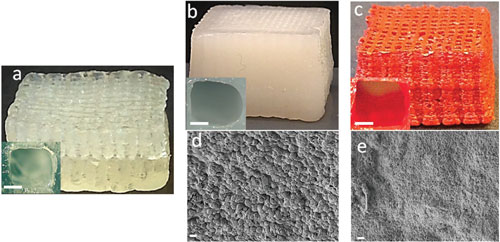| Apr 15, 2019 | |
3D printing MOFs with nanocellulose(Nanowerk News) Nanocellulose has gained popularity in 3D printing because of its rheological properties, hydrophilicity, nontoxicity, and versatile surface chemistry. The fabrication of nanocellulose-based materials using 3D printing for complex structures has potential for economic large-scale processing. |
|
| For instance, nanocellulose dramatically improves the 3D-printability of carbon nanotubes for wearable electronics. Researchers are also equipping nanocellulose with additional functionalities to produce implants for cartilage diseases using 3D printing. | |
| In addition, printed cellulose has advanced applications such as printed electronics, biomedical devices, energy storage, construction, separations, cosmetic, and food applications. | |
| 3D printing of nanocellulose has been reported using several methods, including matrix-assisted 3D printing, direct ink writing, and stereolithography. | |
| Reporting their work in Advanced Functional Materials("CelloMOF: Nanocellulose Enabled 3D Printing of Metal–Organic Frameworks"), researchers at Stockholm University have recently demonstrated a 3D printable hydrogel ink containing metal-organic frameworks (MOFs). The synthesis and printing processes take place at room temperature using water as a solvent. | |
 |
|
| a–c) Photos of 3D printed scaffolds: TOCNF, 4CelloZIF8, and 4CelloZIF8-Cur. Insets are images representing the pores, with the scale bar of 0.5 mm. d,e) SEM images of scaffold b, 4CelloZIF8 and scaffold c, 4CelloZIF8-Cur. Scale bar = 1 µm. (Reprinted with permission by Wiley-VCH Verlag) (click on image to enlarge) | |
| This is a new processability route of MOFs using 3D printing of oxidized cellulose nanofibers incorporated with ZIF-8 and MIL-100 (Fe). The scientists named this system CelloMOF. | |
| This synthesis approach can be used to encapsulate drugs such as curcumin and methylene blue into the CelloMOF systems. | |
| The hybrid inks are printed using simple and inexpensive 3D printer, which can be used by both experts and nonspecialists, extending the use of 3D-printed CelloMOFs in several applications, including water purification, air purification, catalysis, sensors, etc. | |
| "We believe that this work provides a new proof-of-concept prospect for MOFs processing that is flexible, simple, fast, promising for large-scale production and for uptake and release of a variety of guest molecules," trhe authors conclude their report. |
 By
Michael
Berger
– Michael is author of three books by the Royal Society of Chemistry:
Nano-Society: Pushing the Boundaries of Technology,
Nanotechnology: The Future is Tiny, and
Nanoengineering: The Skills and Tools Making Technology Invisible
Copyright ©
Nanowerk LLC
By
Michael
Berger
– Michael is author of three books by the Royal Society of Chemistry:
Nano-Society: Pushing the Boundaries of Technology,
Nanotechnology: The Future is Tiny, and
Nanoengineering: The Skills and Tools Making Technology Invisible
Copyright ©
Nanowerk LLC
|
|
|
Subscribe to a free copy of one of our daily Nanowerk Newsletter Email Digests with a compilation of all of the day's news. |
